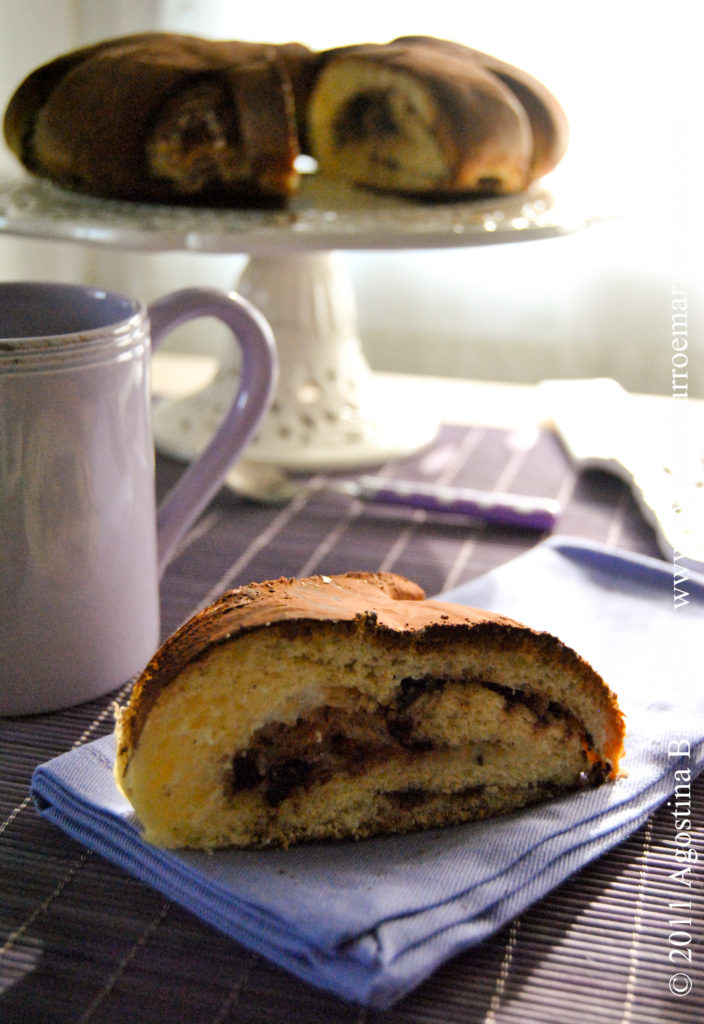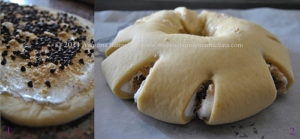[Click here to read the English Version]
Oggi voglio mostrarvi qualcosa che mi è piaciuto tantissimo preparare, sperimentare, ma soprattutto mangiare 😀
Si tratta di una Coffee Cake,una M-E-R-A-V-I-G-L-I-O-S-A brioche servita usualmente a colazione o per il brunch, accompagnata da caffè (da qui deriva il suo nome) o quello che vi pare. In effetti questo post doveva uscire ieri, per la nostra rubrica mensile dedicata alla colazione, ma in questo momento “Pane, burro e marmellata” si trova lontano da casa sua, è volato oltre le nuvole e quindi anche il tempo per veder pubblicato sulle sue pagine ciò che vorrebbe, è molto ridotto… ma voi capite, vero? 🙂
La ricetta di questa brioche è stata trovata da Jamie di Life’s a Feast tra le ricette di suo padre, risalenti al 1970…si trovava scritta su un pezzo di carta ingiallita, come tutte le ricette antiche che vale la pena non dimenticare!
Fu così insomma che Jamie pensò di proporla per la sfida dei Daring Bakers di questo mese.
Mi è piaciuta molto, con la sua pasta deliziosamente profumata allo zafferano, la meringa che praticamente viene assorbita nell’impasto, ma lo mantiene umido ed il suo ripieno particolarissimo per il quale ho seguito le indicazioni di Ria di Ria’s Collection, utilizzando il Garam Masala: ero molto incerta nella riuscita dei sapori, in fondo, il Garam Masala non è una spezia che utilizzo di solito nei dolci, ma credetemi, è stato uno dei più bei esperimenti che io abbia mai fatto! 😀
Coffee Cake Ripiena Meringata
Per 2 brioches, ciascuna di circa 20 centimetri di diametro
Per l’impasto:
600 gr. di farina Manitoba (W380)
55 gr di zucchero
5 gr di sale
1 cubetto di lievito di birra
180 ml di latte intero (o di soia)
60 ml di acqua
135 gr di burro a temperatura ambiente (o 120 gr di burro chiarificato)
2 uova grandi a temperatura ambiente
10 pistilli di zafferano
(possono essere anche sostituiti da 1 cucchiaino di Cardamomo o noce moscata a piacere – se non amate le spezie, potete anche ometterle)
Per la meringa:
3 albumi a temperatura ambiente
¼ di cucchiaino di sale
½ cucchiaino di vaniglia
110 gr di zucchero
Per il ripieno:
130 gr di nocciole tritate grossolanamente
30 gr di zucchero semolato
½ cucchiaino di Garam Masala* – se non lo avete omettetelo
180 gr di gocce di cioccolato fondente
Per lucidare:
1 uovo sbattuto
Cacao in polvere (facoltativo) e zucchero a velo per spolverizzare
Preparare la pasta
In una casseruola, unire il latte, l’acqua e il burro e porre sul gas a fuoco medio. Appena il burro è fuso, levare dal gas ed aggiungere i 10 pistilli di zafferano; lasciare in infusione per 10 minuti.
Passato questo lasso di tempo, sciogliervi anche il lievito.
Lo zafferano darà alla miscela un aroma particolarmente delicato ed un leggero colore giallo -arancio.
Faer una fontana con la farina ed iniziare ad impastare, aggiungendo i liquidi e le uova, sbattendo l’impasto fino a che è tutto ben amalgamato – ci vorranno circa 8/10 minuti. Otterrete un bell’impasto setoso ed elastico.
Infarinare una terrina e disporvi delicatamente l’impasto ottenuto. Coprite con pellicola trasparente e lasciate lievitare fino al raddoppio, circa 60 minuti.
Preparare il ripieno
Una volta che l’impasto è raddoppiato, preparare la meringa.
Montate gli albumi con il sale, per 30 secondi a bassa velocità, poi aumentare e continuare a battere a neve. Aggiungere la vaniglia e poi iniziare ad aggiungere lo zucchero in 3 riprese. Continuare a sbattere, fino a che la meringa non risulti ben soda e lucida.
Montaggio del dolce
Dividere l’impasto a metà. Su una superficie leggermente infarinata, lavorare un pezzo di pasta alla volta (mantenere l’altra metà della pasta avvolta in pellicola), stendere la pasta in un rettangolo (circa 40 x 20 cm). Spalmate metà della meringa uniformemente sul rettangolo fino a circa 3/4 cm dai bordi. Cospargete metà del ripieno su tutta la meringa, quindi metà del composto di zucchero-nocciole-garam masala e la metà delle gocce di cioccolato) – fig.1.
Arrotolare l’impasto su se stesso, dal lato lungo. Pizzicare il bordo e chiuderlo. Facendo molta attenzione, trasferire il rotolo ripieno su una placca foderata, con la parte aperta rivolta verso il basso. Unire le estremità del rotolo, formando un anello, infilando un’estremità nell’altra e sigillando bene – fig.2.
Usando le forbici da cucina, praticare dei tagli lungo il bordo esterno lasciando almeno 2 e 1/2 cm di distanza tra un taglio e l’altro.
Ripetere l’operazione con il restante impasto, meringa e ripieno.
Coprire entrambe le brioches con pellicola trasparente e far lievitare per ulteriori 60 minuti.
Preriscaldare il forno a 180°.
Lucidare con l’uovo sbattuto. Cuocere in forno preriscaldato per 30 minuti fino a quando la superficie è lucida e dorata e la brioche rimanda un suono sordo, se sbattuta.
Sfornare e lasciar raffreddare.
Appena fredde, spolverizzare con zucchero a velo e con cacao amaro.
E’ ottima se consumata immediatamente, ma se conservata in un portatorta o in una scatola di latta, si mantiene morbida ed umida anche per diversi giorni.
The March 2011 Daring Baker’s Challenge was hosted by Ria of Ria’s Collection and Jamie of Life’s a Feast. Ria and Jamie challenged The Daring Bakers to bake a yeasted Meringue Coffee Cake.
FILLED MERINGUE COFFEE CAKE
Makes 2 round coffee cakes, each approximately 10 inches in diameter
For the yeast coffee cake dough
4 cups flour
¼ cup sugar
¾ teaspoon salt
1 package active dried yeast
¾ cup whole milk (or soy milk)
¼ cup water (doesn’t matter what temperature)
½ cup unsalted butter at room temperature (or ghee)
2 large eggs at room temperature
10 strands saffron
For the meringue
3 large egg whites at room temperature
¼ teaspoon salt
½ teaspoon vanilla
½ cup sugar
For the filling
1 cup chopped hazelnuts
2 Tablespoons granulated sugar
½ teaspoon garam masala
1 cup semisweet chocolate chips
Egg wash
1 beaten egg
Cocoa powder (optional) and confectioner’s sugar for dusting cakes
Directions
Prepare the dough:
In a saucepan, combine milk, water and butter and place over medium heat. Once the butter has just melted, add 10 strands of saffron and leave to infuse for 10 minutes.
This will give the mixture an especially delicate smell and a light-yellow color.
Make a mound of flour and start kneading, adding the liquid and eggs, beating the mixture until everything is well blended – it will take about 8 / 10 minutes. You’ll get a sexy and elastic dough.
Flour a bowl and arrange the mixture gently. Cover with plastic wrap and let rise until doubled, about 60 minutes.
Prepare the filling
Once the dough has doubled, prepare the meringue.
Beat the egg whites with salt for 30 seconds at low speed, then increase and continue beating until stiff. Add the vanilla and then start adding the sugar in 3 rounds. Continue to whisk, until very stiff, glossy peaks form.
Assemble the Coffee Cakes
Punch down the dough and divide in half. On a lightly floured surface, working one piece of the dough at a time (keep the other half of the dough wrapped in plastic), roll out the dough into a 20 x 10-inch (about 51 x 25 ½ cm) rectangle. Spread half of the meringue evenly over the rectangle up to about 1/2-inch (3/4 cm) from the edges. Sprinkle half of your filling of choice evenly over the meringue (ex: half of the cinnamon-sugar followed by half the chopped nuts and half of the chocolate chips/chopped chocolate).
Now, roll up the dough jellyroll style, from the long side. Pinch the seam closed to seal. Very carefully transfer the filled log to one of the lined cookie sheets, seam side down. Bring the ends of the log around and seal the ends together, forming a ring, tucking one end into the other and pinching to seal.
Using kitchen scissors or a sharp knife (although scissors are easier), make cuts along the outside edge at 1-inch (2 ½ cm) intervals. Make them as shallow or as deep as desired but don’t be afraid to cut deep into the ring.
Repeat with the remaining dough, meringue and fillings.
Cover the 2 coffee cakes with plastic wrap and allow them to rise again for 45 to 60 minutes.
Preheat the oven to 350°F.
Brush the tops of the coffee cakes with the egg wash. Bake in the preheated oven for 25 to 30 minutes until risen and golden brown. The dough should sound hollow when tapped.
Remove from the oven and slide the parchment paper off the cookie sheets onto the table. Very gently loosen the coffee cakes from the paper with a large spatula and carefully slide the cakes off onto cooling racks. Allow to cool.
Just before serving, dust the tops of the coffee cakes with confectioner’s sugar and cocoa powder, if using chocolate in the filling. These are best eaten fresh, the same day or the next day.








